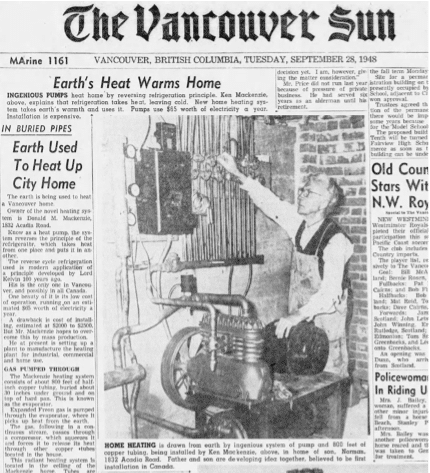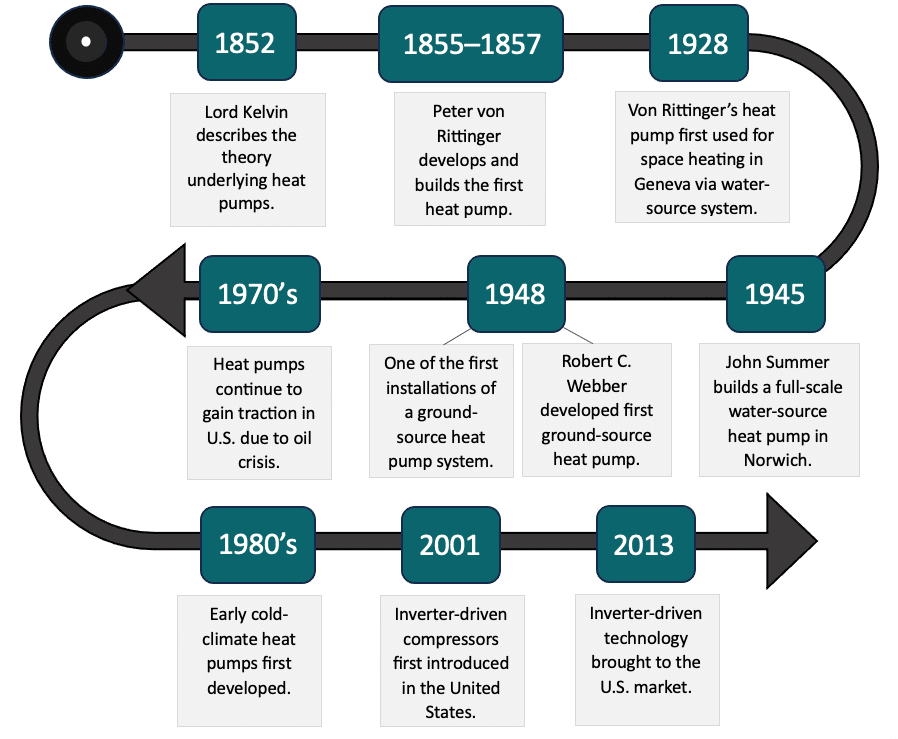Heat pumps — all-electric, super-efficient temperature control appliances that can both heat and cool indoor spaces — are a key to decarbonizing heating, especially as the grid is served increasingly by carbon-free resources. The 2022 Inflation Reduction Act (IRA), the biggest climate investment in U.S. history, includes funding for electrification efforts to increase the widespread adoption of heat pumps; however, hesitation about performance and efficiency continue to inhibit their widespread acceptance and adoption, as many are not aware of the significant improvements in heat pump technology.
In this blog, first in a series, we explore how heat pumps have evolved over time — in particular, highlighting how newer models boast features that allow their efficient use for heating in colder climates.

Early History of Heat Pumps
Early heat pumps were conceptualized in the 1850s, with construction of the first working model from 1855-1857. Heat pumps weren’t adopted, however, until the early 20th century, when early refrigeration systems were developed. Early heat pump systems only moved air one way and were used for cooling and refrigeration. Later development of the reversing valve allowed systems to change the flow of refrigerant and enabled heating functionality in the same system. (A water-source heat pump, installed in Zurich, Switzerland’s city hall in 1937, heated the building for decades until 2001.)
In the 1940s and ’50s, early versions of the ground-source heat pump were developed; the Vancouver Sun reported on the installation of one such system in September 1948 (see “Earth’s Heat Warms Home,” above).
In the 1980s and ’90s, heat pump manufacturers began developing heat pumps specifically for use in cold climates. These cold climate heat pumps (CCHP) had unique features such as reverse cycle defrost, and more efficient two- and variable-speed compressors that made effective heating possible even in extremely cold outdoor temperatures.

Efficiency Up a Notch
Early heat pumps ran at full capacity and power regardless of environmental conditions. Consequently, they were likely to overshoot their set point or desired temperature. This led in turn to wasted energy because they cycled on and off as the indoor temperature drifted above and below the set point. Early heat pumps also struggled to meet heating demand in especially cold climates, leading to concerns about customer comfort during cold months.
Heat pumps got by with this basic performance and efficiency in the early 1990s when efficiency requirements by the U.S. Department of Energy (DOE) were relatively low (SEER was 10 and HSPF was just under 7). However, as the focus on energy efficiency grew and as efficiency requirements evolved, the DOE continued to raise its efficiency standards, creating a demand for more efficient heat pump technology. In response to this need, Japanese engineers developed the first inverter-driven compressors (1980-81); these systems save energy by running continuously and ramping capacity up and down as needed. This ushered in the era of the variable-capacity heat pump, and by 2001, Japanese manufacturers were selling their technology on the U.S. market.
Measuring Efficiency
Heat pump performance is measured using a few different metrics:Cooling efficiency is measured using the seasonal energy efficiency ratio (SEER).
Heating efficiency is measured using heating seasonal performance factor (HSPF), or coefficient of performance (COP).
SEER and HSPF are the most readily used metrics for rating performance. Generally, the higher the rating, the better the efficiency.
Modern Heat Pumps Overcome Concerns about EE and Capacity
Early heat pump adopters likely experienced limited heating capacity at low outdoor temperatures. However, the myth that heat pump technology is still most effective in mild climates has persisted even today, creating an obstacle to the widespread adoption of heat pumps. Today’s cold climate heat pumps provide customers with a highly effective space heating and cooling performance that is readily available at a reasonable cost. Today’s heat pumps are based on the original concept but employ decades of technological advancements in performance and efficiency.
Cold climate heat pumps have specialized features that enable them to provide reliable, effective heating below 15-20 degrees F, with many models operating at outdoor temperatures as low as -20 degrees F. Cold climate heat pumps today may outperform standard heat pump models reaching nearly 400% efficiency (compared to around 300% efficiency for a standard heat pump).
Some of the features that allow cold climate heat pumps to perform more efficiently and in a wider range of operation include:
- Variable speed compressors and fans that adjust compressor speed to match the conditioning load, eliminating the need to run at full capacity at all times.
- Enhanced vapor injection sacrifices some peak efficiency to improve overall efficiency by cycling small quantities of refrigerant though a heat exchanger before returning it at a warmer temperature, to the compressor.
- Electronic expansion valves are metering devices that provide more precise metering of refrigerant flow.
- Sensors and controls help optimize operation by matching refrigerant flow and volume to the compressor and fan speed.
Heat pumps have made incredible strides over the years, and are likely to continue increasing efficiency and performance, while decreasing their climate footprint in the future.
Next week, this series will take a look at how these advances have allowed heat pumps to become an effective winter heating solution in a particular place known for its cold winters: Maine, where the deployment of heat pumps is helping the state move toward ambitious emissions reduction goals.
Vivian Cox is a senior climate policy analyst at CLASP.
